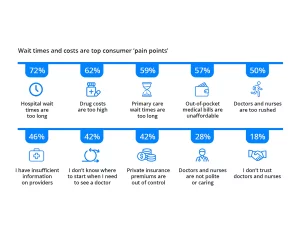All providers service areas like Physician’s, Labs, Pharmacies Hospitals and home care face a unique set of challenges that lead to high dissatisfaction among the provider community. Changing consumer expectations are leading to further pressure on Providers to relook at their workflows and move from conventional practice methods to Practice Smart. Absence of changes will lead them to patient moving to other providers and financial stress.
Provider Pain points and inefficiency can be reduced by digital transformation that will meet the higher expectations of consumers who are looking for an e-commerce speed in healthcare transactions. ActiveMD a provider portal of Active Wellness provides providers with the tools and frameworks that will do the following:
- Enhance customer satisfaction,
- Increase patient flow,
- Reduce dropouts and
- Increase visibility in patient community beyond traditional boundaries.
- Hybrid care model provides the best of both worlds to all the stakeholders.
- Prevent Stress and burnout.
- A Practice Management System. For more Click here
A typical Physician is very dedicated and works very hard. The typical life of a provider is full of stress and health issue for the benefit of her patients. This can be anyone’s story.
Dr. Vandana chose a career in medicine because of her passion for helping others and making a positive impact on people’s lives. She found herself facing an increasing burden that affected her ability to provide the best care possible.
Her day started early, with a long list of patients waiting to be seen. As she walked through the hospital corridors, she couldn’t help but notice the constant stream of activity around her.
Nurses hurriedly attended to patients, machines beeped, and the constant ringing of phones filled the air. Amidst the chaos, Dr. Vandana did her best to remain focused and provide compassionate care.
With an ever increasing schedule became packed with back-to-back appointments. The time allocated for each patient was limited, leaving her with little opportunity to truly connect with them or address their concerns adequately.
She had to rush through consultations, trying to gather as much information as possible in a short amount of time.
To make matters more challenging, she faced the burden of excessive administrative tasks. Electronic health record (EHR) systems, which were meant to streamline processes, often added to her workload as they were not designed with a provider in mind where delegation to the consumer and the support staff was not present. .
A significant amount of time documenting patient visits, entering data, and navigating through complex interfaces left her with less time for direct patient care and contributed to mounting frustration and burnout.
Grappling with the pressure of making critical decisions quickly stressed her due to the potential possibility of making mistakes. The limited time required her to consider various factors, review medical histories, interpret test results, and consult with colleagues—all while ensuring patient safety and making the best possible treatment choices.
The pressure and extended working hours left her with no personal time.
Despite these challenges, Dr. Vandana remained resilient and dedicated to her profession.
She sought support from her colleagues, attending support groups, and engaging in self-care activities to manage the burden.
She was so overwhelmed with stress that she suffered a breakdown and had to be treated.
Her pleas for system-level changes within the hospital, highlighting the importance of adequate staffing, improved workflows, and better work-life balance for healthcare providers yielded limited or no results..
Dr. Vandana’s story highlights the heavy burden that healthcare providers face in hospitals. It emphasizes the need for organizational support, improved workflows, and resources to alleviate the strain on providers and enable them to deliver the highest quality of care to their patients.
It also sheds light on the resilience and unwavering commitment of healthcare professionals who continue to navigate these challenges while putting their patients’ well-being first.
In the above background we will not look at the multiple pain points being faced by them while trying to help patients.

Common Provider Pain Points
1. Regulatory Compliance
Providers often need to navigate complex regulatory environments and ensure that they comply with various industries specific regulations. This can be time-consuming and costly.
2. Reimbursement and Payment Issues
In sectors like healthcare, providers struggle with issues related to insurance claims, reimbursement delays, and payment disputes. These challenges can affect their cash flow and financial stability. Not getting reimbursements for treatment given on time from the government.
3. Technology Adoption
Keeping up with rapidly evolving technologies can be challenging for providers. Implementing new systems or upgrading existing ones can be costly and require significant staff training. This can be reduced by implementing digital approaches such as Active Wellness solutions.
Providers need to opt for plug-and-play cloud services and focus on their core competence of providing care.
4. Data Security and Privacy
With the increasing digitalization of operations, providers need to ensure the security and privacy of sensitive data. Cyber security threats and the need to comply with data protection regulations can be discouraging ONLY cloud services overcome this
5. High Competition
Intense competition for customers or clients saturates many industries, leading to a saturation of providers. This can put pressure on pricing and differentiation strategies. – More providers in metropolitan areas and fewer in rural areas leads to geographical mismatches.
6. Changing Consumer Expectations
Consumer expectations are evolving, and providers must adapt to meet these new demands. This could involve providing more personalized experiences, convenient access, or improved customer service. Consumers are looking for an e-commerce-like experience
7. Resource Management
Efficiently managing resources like staff, equipment, and supplies can be a challenge. Overstaffing or underutilization of resources can impact profitability.
8. Communication and Coordination
Especially in sectors like healthcare, effective communication, and coordination among different departments or teams are crucial. Inefficiencies in this area can lead to errors or delays.
The robust communication framework allows providers to communicate between the care team members and also with the patients in real time. ONLY Platform with this capability.
9. Market Volatility
Economic fluctuations and market uncertainties can impact the demand for services. Providers need to have strategies in place to navigate through these changes.
10. Talent Acquisition and Retention
Finding and retaining skilled and qualified personnel can be difficult, particularly in industries facing talent shortages or high turnover rates.
11. Customer Relationship Management
Building and maintaining strong relationships with customers or clients is essential. Poor customer satisfaction can lead to a loss of business and reputational damage.
12. Scaling Operations
When providers experience growth, they may struggle with effectively scaling their operations to meet increased demand. Issues might arise in maintaining quality, expanding infrastructure, and managing the growing customer base.
Brick-and-mortar that do not have a Hybrid care model will not be able to scale or reach beyond a limited territory.
13. Risk Management
Providers need to prepare for potential risks, whether they are financial, legal, operational, or related to reputation. Developing risk management strategies is crucial.
14. Sustainability and Environmental Concerns
Stakeholders increasingly expect providers to address sustainability and environmental concerns.
Pain Points Faced by Providers in Hospitals
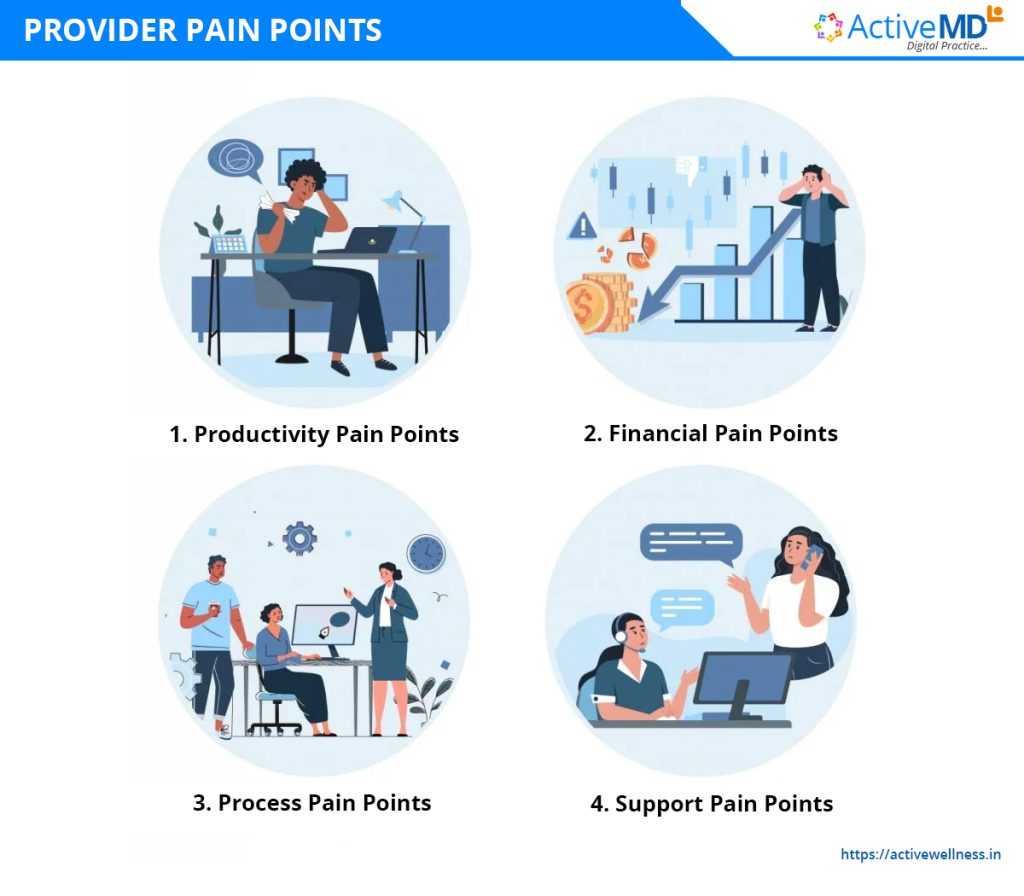
Stress & Pressure Faced by Providers in Hospitals
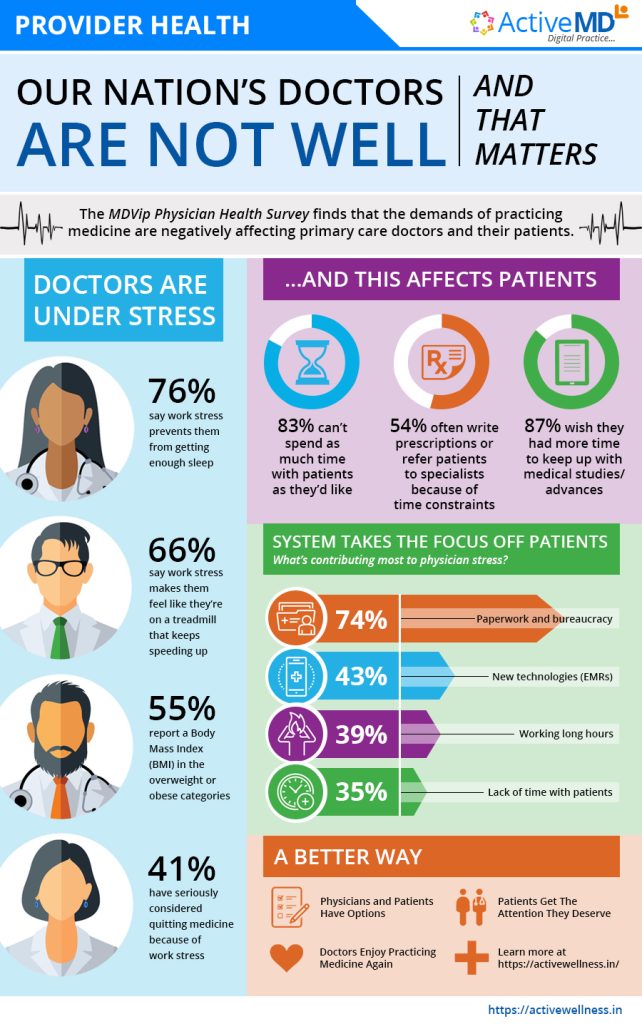
Healthcare providers in hospitals face a variety of pain points that can impact their ability to deliver high-quality care and contribute to overall patient satisfaction. Some of these pain points include
1. High Workload
Healthcare providers often endure long hours and face emotionally and physically demanding situations. This can lead to fatigue, affecting both the quality of care they provide and their own well-being.
2. Administrative Burden
Providers often spend a significant amount of time on administrative tasks such as documentation, billing, and navigating complex electronic health record (EHR) systems. This diverts time away from direct patient care.
3. Limited Time with Patients
Due to the administrative burden and high patient load, providers may have limited time to spend with each patient. This can hinder their ability to establish strong patient-provider relationships and fully understand the patient’s needs.
4. Lack of Interoperability
Many hospitals use different EHR systems that may not communicate effectively with each other. This can lead to difficulties in accessing patient records and sharing information between different departments or facilities. Indeed, healthcare organizations commonly use scanning and PDFs as methods for digitization.
Healthcare organizations should adopt new technologies to pull all the relevant data from the patients.
5. Patient Satisfaction and Expectations
Meeting patient expectations while adhering to medical best practices can be challenging. Patients may have unrealistic expectations, and providers must balance these with providing evidence-based care.
6. Emotional Toll
Healthcare providers frequently deal with patients who are in pain or distress, which can take an emotional toll on them. Coping with patient suffering while maintaining professionalism can be challenging.
7. Continuing Education
Medicine is a rapidly evolving field, and providers must stay up-to-date with the latest medical advancements and treatment guidelines. This requires continuous learning, which can be difficult to fit into their busy schedules.
8. Ethical Dilemmas
Providers may encounter ethical dilemmas related to end-of-life care, resource allocation, and other sensitive issues. These decisions can be emotionally and morally challenging.
9. Work-Life Balance
The demanding nature of healthcare can make it difficult for providers to achieve a healthy work-life balance, which can contribute to burnout and impact their overall well-being.
10. Communication Challenges
Effective communication among healthcare teams is crucial for patient safety and coordinated care. Operating silos is one of the major reason for fragmented communication.
Using Active Wellness Provider Solutions (ActiveMD) can reduce the burden on providers as it embeds E-consult Workflows, offers manageable appointment slots, and provides 24/7 availability for tele-consults, benefiting the provider.
Pain Points Faced by Hospitals

Hospitals face a variety of pain points, which can vary based on factors like location, size, patient demographics, and available resources. Here are some common pain points faced by hospitals:
1. Financial Challenges
Hospitals often struggle with financial issues, including the high cost of medical equipment, staff salaries, and maintaining facilities. Reimbursement challenges from insurance companies and government programs can also lead to financial strain.
2. Staffing Shortages
Recruiting and retaining qualified healthcare professionals, including doctors, nurses, and support staff, can be difficult. Staffing shortages can lead to increased workloads, burnout, and compromised patient care.
3. Patient Flow and Capacity Management
Hospitals need to manage patient admissions, discharges, and transfers efficiently to optimize bed capacity and reduce wait times. Overcrowding can lead to compromised patient care and lower patient satisfaction.
4. Medication Errors and Patient Safety
Hospitals need to maintain strict protocols to prevent medication errors, infections, and other safety issues. Failure to do so can lead to harm to patients and legal liabilities.
5. Emergency Preparedness
Hospitals must prepare themselves for emergencies such as natural disasters, pandemics, and mass casualty incidents. Developing and maintaining comprehensive emergency response plans is a constant challenge.
6. Supply Chain Disruptions
Hospitals need a steady supply of medical equipment, pharmaceuticals, and other essential supplies. Disruptions in the supply chain, whether due to global events or manufacturing issues, can impact patient care.
All of the above-mentioned pain points can eliminate by using Active Wellness Solutions’ home care plans. It keeps you connected with your patient. Home care services help you reach your goals.
There will be no medication errors, and risks are detected in advance, so there will be no emergency for patients. As Active Wellness has AI engines, there will be no shortage of staff members when the patients need them
The Interfaces Between Hospitals to Provide Care In India
1. Referral System
Many hospitals, especially smaller ones, refer patients to larger, specialized hospitals for more advanced treatments or procedures that they cannot handle. This is common in cases where a patient’s condition requires expertise or facilities that are not available at the referring hospital.
2. Telemedicine and Teleconsultation
Telemedicine has grown in popularity as technology has advanced. Hospitals and clinics in remote areas can connect with larger hospitals in urban centers for consultations through video conferencing and other digital communication tools. This helps in providing expert opinions and advice to patients who might not have easy access to specialist care.
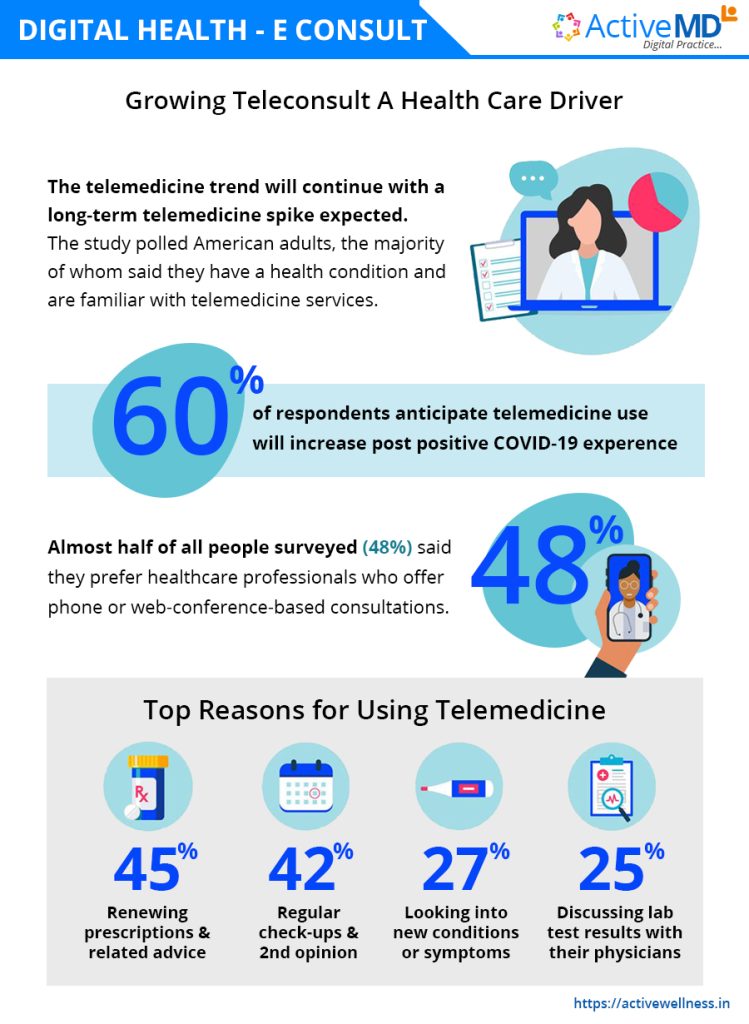
3. Medical Tourism
India is known for attracting medical tourism, where patients from other countries travel to India for medical treatments. Hospitals that specialize in treating international patients often collaborate with local hospitals to provide a continuum of care.
4. Public-Private Partnerships (PPPs)
In some cases, there are collaborations between government-run hospitals and private hospitals. This might involve sharing resources, expertise, or facilities to improve healthcare services in a particular region.
5. Resource-Sharing
Hospitals might collaborate to share resources such as medical equipment, specialized facilities, or even staff in cases of emergencies or during peak demand periods.
6. Health Camps and Outreach Programs
Hospitals, especially those in urban areas, might organize health camps and outreach programs in rural or underserved areas. These programs help provide basic medical care, screenings, and awareness campaigns. There is a RURAL vs URBAN disparity that get addressed by the ActiveMD solution.
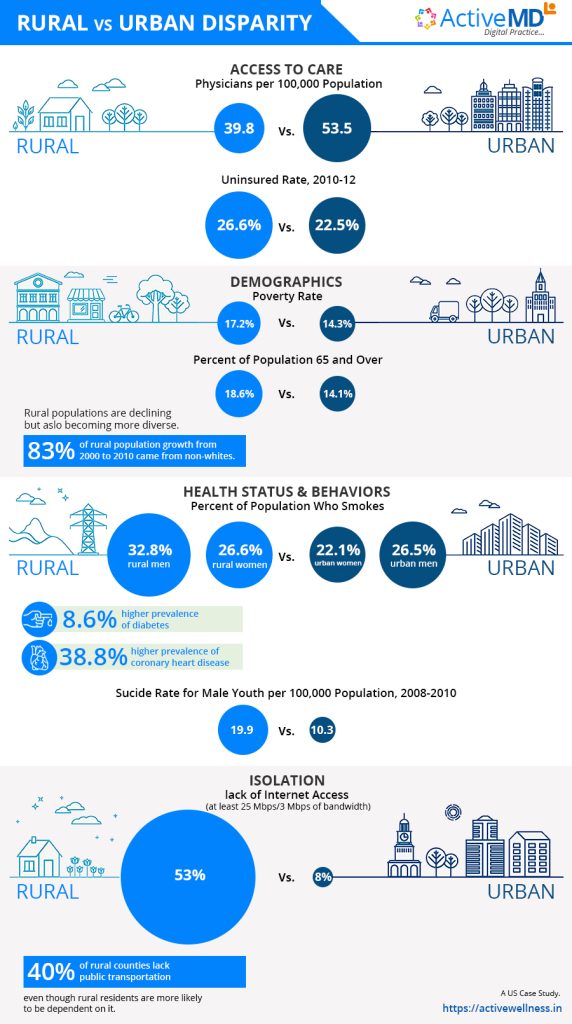
7. Transplant Networks
Hospitals specializing in organ transplantation might collaborate to create a broader network for organ-sharing and transplantation procedures.
8. Cancer Care Networks
Some hospitals collaborate in cancer care networks to ensure that cancer patients receive comprehensive and coordinated care across different treatment modalities.
The Interface Between Providers To Provide Care To Patients In India
1. Primary Health Centers (PHCs) and Sub-Centers
These are the first points of contact for patients in rural areas. PHCs provide basic healthcare services, while sub-centers focus on preventive and basic curative care. They act as gateways to more specialized care.
2. Community Health Centers (CHCs)
These centers offer more advanced healthcare services compared to PHCs and serve as a referral point for cases that cannot be handled at the primary level
3. District Hospitals
It is equipped to provide more comprehensive healthcare services and serve as referral points for cases that cannot be managed at PHCs or CHCs.
4. Medical Colleges and Teaching Hospitals
These institutions play a crucial role in providing medical education and training future healthcare professionals. They also provide specialized and advanced medical care.
5. Specialty Hospitals
These hospitals focus on specific medical specialties such as cardiology, orthopedics, oncology, etc. Patients are often referred to these hospitals when their conditions require specialized care.
6. Private Hospitals and Clinics
The private sector plays a significant role in healthcare for patients in India. Private hospitals and clinics offer a wide range of services and are often chosen for their perceived quality and convenience.
7. Government Programs
The Indian government runs various healthcare programs, such as the National Health Mission (NHM), Ayushman Bharat, and various state-specific initiatives. These programs aim to provide affordable and accessible healthcare services to a broader population.
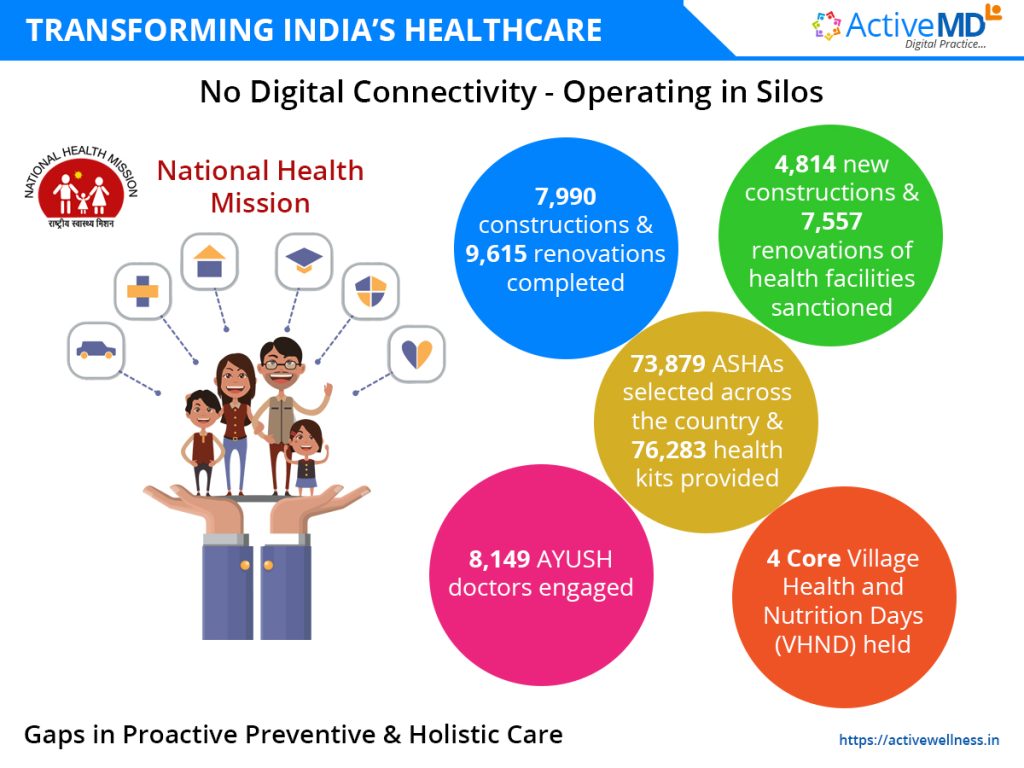
8. Non-Governmental Organizations (NGOs)
Numerous NGOs in India work to provide healthcare services to underserved communities. They often bridge the gap between government initiatives and community needs.
9. Pharmacies and Chemists
These play a critical role in dispensing medications and over-the-counter medical supplies. They are often the first point of contact for patients seeking advice on minor health issues.
Providers Work In Silos – This Impacts Patients Care
1. Public vs. Private Healthcare
India has both public and private healthcare sectors. Public healthcare is often provided by government-run hospitals and clinics, while the private sector includes a range of hospitals, clinics, and individual practitioners. These sectors often operate independently, leading to disparities in quality and accessibility.
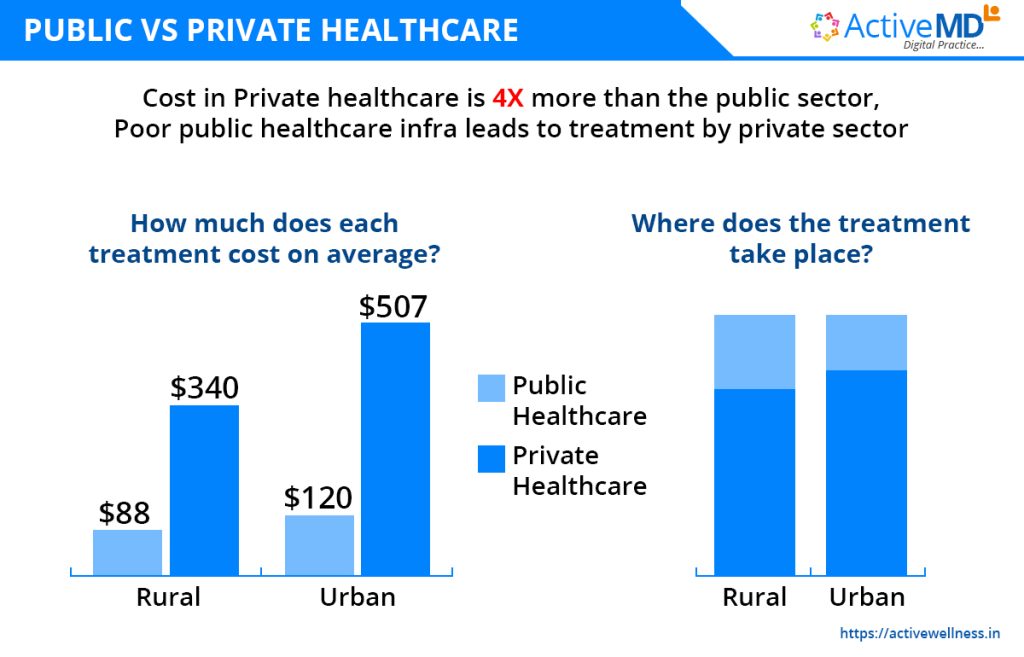
2. Urban vs. Rural Healthcare
Healthcare infrastructure and services can vary significantly between urban and rural areas. Urban areas generally have better access to advanced medical facilities, specialized care, and skilled healthcare professionals.
Rural areas often face challenges such as a lack of healthcare facilities and qualified medical staff in the field these limitations need to be met by . have limitations, and not all healthcare providers participate in them, creating a divide in access.
EXPECTATION CHANGE WITH AGE AND TIME
Millennials Expectation form Healthcare Providers

1. Patient Engagement
Healthcare providers might anticipate millennials to be active participants in their healthcare decisions. They could expect millennials to ask more questions, seek second opinions, and engage in shared decision-making regarding treatment options.
2. Desire for Convenience
Providers might anticipate millennials valuing convenience and efficiency in healthcare services. This could involve offering extended clinic hours, same-day appointments, and quick access to test results.
3. Health Information Seeking
Providers might expect millennials to be proactive in seeking health information online. However, they might also expect them to critically evaluate the credibility of sources and be open to discussing the information they find.
Provider Expectations From Gen Z in Healthcare
1. Preventive Attitude
There is a general expectation that Gen Z will place a greater emphasis on preventive health measures. Growing up with increased health awareness and information and online accessibility, Gen Z is more inclined to adopt online management of healthy lifestyle choices and seek regular screenings, preventive check-ups to detect and reverse risk. The online early detection and management will also help in preventing complications.
2. Engagement in Personal Health
Seeing onset of medical fatalities happening at a younger age it is expected that Gen Z will actively engaged in their personal health management. This includes tracking health metrics, getting curated medical information, and taking responsibility for their own well-being.
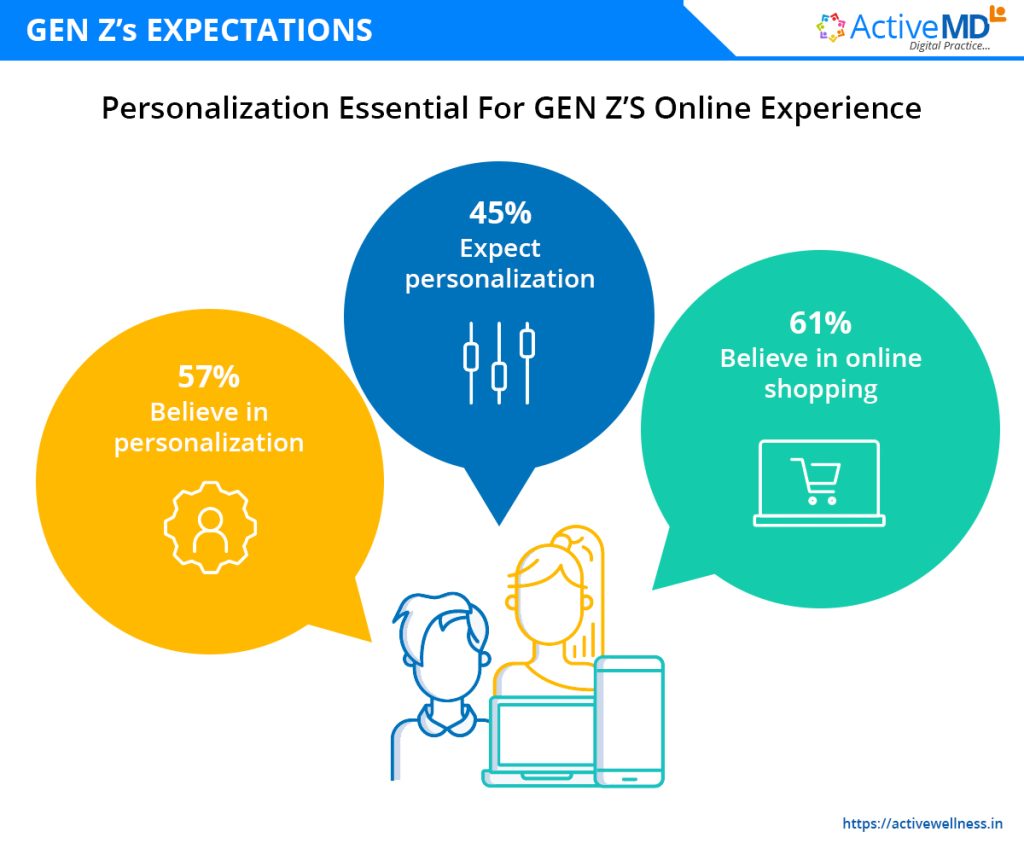
3. Involvement in Decision Making
Gen Z individuals now participates actively in decision making. They are looking for ease and convenience to engage with care teams and access actively participate and have a say in decisions that impact their health & that of their near and dear. Healthcare providers have to acknowledge in this change in the Gen Z patients and be ready to actively discuss treatment plans and be ready to be answer questions and acknowledge that they will seek second opinions.
The Millennial Expectations From Providers
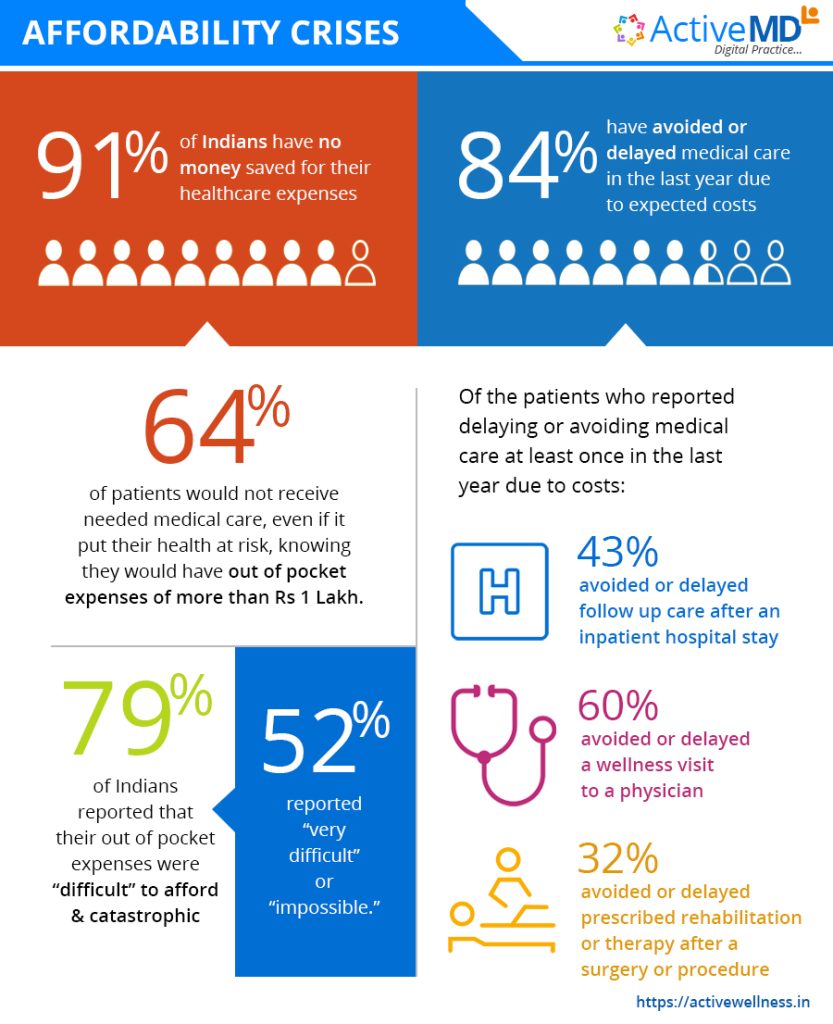
Here are some general expectations that millennials might have from service providers:
1. Personalization
Millennials value personalized experiences. They are more likely to engage with providers that tailor their offerings to individual preferences and needs. This can include personalized recommendations, relevant content, and customized product or service options.
2. Transparency, Authenticity & Value For Money
Millennials tend to appreciate businesses that offer Value for Money: While Millennials might be willing to spend on quality products and services, they are also conscious of their finances due to the economic challenges many have faced in the past. They expect providers to offer reasonable pricing and good value for the cost.
3. Feedback and Engagement
Millennials appreciate opportunities to provide feedback and engage in the delivery of care and services. They expect Providers to listen to their feedback and make improvements based on their suggestions.
The Gen Z Expectations From Providers
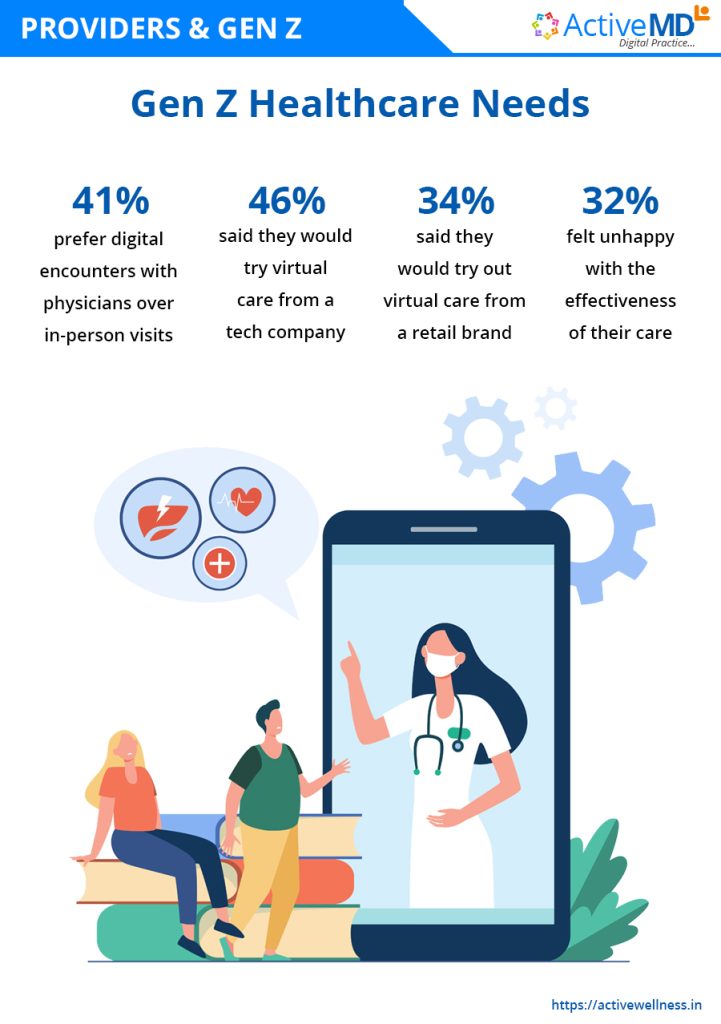
1. Instant Communication
Gen Z living in an environment where real-time communication through messaging apps and social media is there way of life. They expect healthcare providers to be prompt and efficient in customer service, often preferring text-based communication over traditional phone calls.
2. Quality and Value
While they appreciate affordability, Gen Z is also willing to invest in products and services that provide quality and long-term value. Here proactive preventive care steps into play. They look for options that offer a balance between cost and quality.
3. Security and Privacy
Given their growing up in the digital era, Gen Z has more concerns about data privacy and security. They expect healthcare service providers to handle their personal information responsibly and to prioritize cybersecurity.
4. Digital Innovation
Gen Z is attracted to innovative and cutting-edge products and services. They value digital convenience and solutions that will give convenience and precision in care where prevention is preferred over sick care. The increase in Tele-consults is a clear indication.

The Solution:
Provider Ecosystem needs to evolve their processes and go Digital through Plug & Play Systems. This will eliminate the wait and improve customer satisfaction and bring him back for re-care. Active Wellness has been designed by providers for providers. This helps manage care not only in the OPD but after the patients return to the community after discharge. It offers the hybrid care model that gives the comfort and reduce the foot falls in the hospital freeing up resources and enabling better utilization.
No longer will you have long wait lines at the registration counter / filling of forms etc. The provider tool set allows them to create document and record patient history in a very short time and no turning multiple pages to understand previous conditions. See trends, care plans and their evolution on a click. The freed up time of the doctor can be used to deliver patient care. However, there are many benefits to using digital means. One such amazing web 3.0 platform ActiveMD by Active Wellness is the answer to all your queries.
Reference
- https://bhmpc.com/2014/06/8-healthcare-provider-pain-points-pain-points-2/
- https://www.softwareadvice.com/resources/patient-pain-points/
- https://healthipass.com/blog/4-pain-points-of-managing-the-healthcare-revenue-cycle
- https://www.impactguru.com/blog/public-vs-private-healthcare-in-india-the-difference-pros-and-cons
- Active Wellness: https://actviewellness.in
- Active Wellness: https://activewellness.in/activemd/providers.aspx




